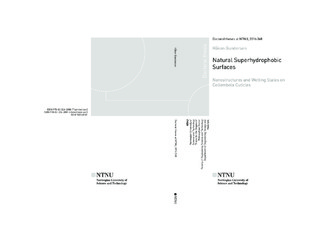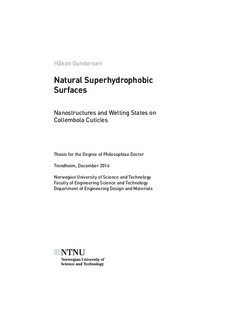| dc.contributor.advisor | Thaulow, Christian | |
| dc.contributor.author | Gundersen, Håkon | |
| dc.date.accessioned | 2017-01-26T12:26:04Z | |
| dc.date.available | 2017-01-26T12:26:04Z | |
| dc.date.issued | 2016 | |
| dc.identifier.isbn | 978-82-326-2081-4 | |
| dc.identifier.issn | 1503-8181 | |
| dc.identifier.uri | http://hdl.handle.net/11250/2428637 | |
| dc.description.abstract | Highly water repellent surfaces, known as superhydrophobic surfaces, have a range of potential applications including self-cleaning, drag reduction and air-retention. The first studies of the superhydrophobic effect was on naturally occurring surfaces, and it was found that superhydrophobicity requires a combination of micro- or nanosized surface structuring and a suitable surface chemistry. Understanding natural superhydrophobic surfaces and their wetting mechanisms can lead to inspiration for the superhydrophobic surfaces of the future. The cuticles of the tiny arthropod Collembola have long been known to be superhydrophobic. The cuticles of Collembola are covered in nanosized surface structures, some of which feature overhang. This compilation thesis combines three articles studying the cuticle structure and wetting of Collembola, they are presented along with a comprehensive introduction to wetting, contact angles, natural and man made superhydrophobic surfaces, providing the necessary context for the three articles. The first article provides a study of twelve different species of Collembola covering a large range of habitats. Ten of these twelve species were found to be superhydrophobic. A detailed comparison of surface structure and wetting properties concludes that there was no direct link between overhanging surface structures and superhydrophobicity on Collembola cuticles. It is further demonstrated that the classic wetting models of Wenzel, Cassie and Baxter are not able to predict the observed contact angles. The second article reports a significant seasonal change in the wetting of the cuticle of a specific species of Collembola. Cryptopygus clavatus is superhydrophobic in winter, but not in summer, and this change in the wetting characteristics is not accompanied by a corresponding change in the cuticular surface structure. The classic wetting models describe a close link between surface structure and wetting characteristics and can not predict this seasonal change. The third article revisits data from the first two articles and succesfully applies a solution presented by Zheng et al. where the three-phase line tension is taken into account. The small size scale of the surface features on Collembola cuticles means that the ratio between the length of the three-phase line and the size of the surface area is very large, which ensures that modest variations of the three-phase line tension can explain large variations in the wetting properties. | nb_NO |
| dc.language.iso | eng | nb_NO |
| dc.publisher | NTNU | nb_NO |
| dc.relation.ispartofseries | Doctoral theses at NTNU;2016:368 | |
| dc.relation.haspart | Paper 1:
Gundersen, Håkon A Holm; Leinaas, Hans Petter; Thaulow, Christian.
Surface structure and wetting characteristics of Collembola cuticles. PLoS ONE 2014 ;Volum 9.(2) s. 1-11
https://doi.org/10.1371/journal.pone.0086783 -
This is an open-access article distributed under the terms of the Creative Commons Attribution License | |
| dc.relation.haspart | Paper 2:
Gundersen, Håkon A Holm; Thaulow, Christian; Leinaas, Hans Petter.
Seasonal change in the wetting characteristics of the cuticle of the Collembola Cryptopygus clavatus (Schött, 1893). Zoomorphology 2015 ;Volum 134.(2) s. 211-218
https://doi.org/10.1007/s00435-015-0254-y
This article is distributed under the terms of the Creative Commons Attribution License | |
| dc.relation.haspart | Paper 3:
Gundersen, Håkon A Holm; Leinaas, Hans Petter; Thaulow, Christian.
Collembola cuticles and the three-phase line tension. Beilstein Journal of Nanotechnology 2017 ;Volum 8.(1) s. 1714-1722
This is an Open Access article under the terms of the Creative Commons Attribution License (http://creativecommons.org/licenses/by/4.0), which permits unrestricted use, distribution, and reproduction in any medium, provided the original work is properly cited.
The license is subject to the Beilstein Journal of Nanotechnology terms and conditions: (http://www.beilstein-journals.org/bjnano) | |
| dc.title | Natural Superhydrophobic Surfaces: Nanostructures and Wetting States on Collembola Cuticles | nb_NO |
| dc.type | Doctoral thesis | nb_NO |
| dc.subject.nsi | VDP::Technology: 500::Materials science and engineering: 520::Functional materials: 522 | nb_NO |
| dc.description.localcode | author version with copyright information | |

